|
July 1949 Popular Science
 [Table of Contents] [Table of Contents]
Wax nostalgic about and learn from the history of early
electronics. See articles from
Popular
Science, published 1872-2021. All copyrights hereby acknowledged.
|
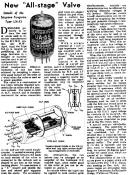
Sargrove-Tungsgram UA-55 Vacuum Tube
In the middle of the last
century, Popular Science magazine ran a monthly news roundup feature
entitled "March of Science." It included topics on electronics, mechanics,
chemistry, medicine, astronomy, oceanography, etc. One of the most interesting
items this July 1949 issue is Consolidated Vultee's Charactron™ cathode-ray
tube, which was specially designed to project text and special characters on the
screen. Electromagnetic deflection coils directed the electron beam first
through a plate perforated with characters, then steered it to a location on the
phosphorescent screen. Interestingly, it appears a patent for the Charactron was
not applied for until 1952. US2735956A was awarded to inventor J. T. McNaney
(shown below) on February 21, 1956. Another notable item is the Sargrove-Tungsgram
UA-55™ radio tube, which "can be made to do the job of any tube in a receiver
from RF to audio output." It was not a single-tube receiver, though; other tubes
were needed before and/or after it for a complete receiver circuit. Presumably a
receiver built entirely from chain of UA-55's could be achieved. A datasheet for the tube is shown to the left.
UA-55 tubes can be found on the German eBay website.
March of Science
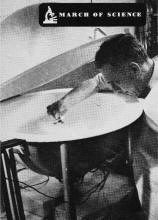 Giant's "Hat" Measures Light. Giant's "Hat" Measures Light.
When this mammoth "derby" swings down it forms a large spherical chamber with
the inverted one below it. Called a photometer, the chamber is used to measure how
much light is emitted by a lamp bulb placed in-side. Here a Westinghouse engineer
inserts a tiny radio-dial bulb for test.
 Alphabet Tube Spells Words. Alphabet Tube Spells Words.
By projecting letters and numbers on its screen (right, below), this new Charactron™
cathode-ray tube can spell out whole messages. Coded impulses guide the tube's beam
to select and position the desired characters, which are cut out like stencils in
a disk inside the tube. Inventor J. T. McNaney, Consolidated Vultee engineer, plans
to use the tube in a receiver to translate incoming code into words, and then record
them on film at up to 1,000,000 a minute.
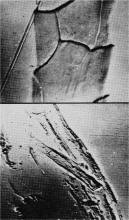 Inside Story of Wear. Why your
wool coat wears out is shown in these pictures made by National Bureau of Standards
scientists with the electron microscope. Originally a fiber of wool has a protective
outer layer of strong interlocking scales (upper view). When this wears off, the
soft inner structure (lower view) is exposed and soon disintegrates into a hole.
The fibers were too thick to view directly, so pictures were made by using plastic
impressions, "shadowed" with a thin chromium coating. Inside Story of Wear. Why your
wool coat wears out is shown in these pictures made by National Bureau of Standards
scientists with the electron microscope. Originally a fiber of wool has a protective
outer layer of strong interlocking scales (upper view). When this wears off, the
soft inner structure (lower view) is exposed and soon disintegrates into a hole.
The fibers were too thick to view directly, so pictures were made by using plastic
impressions, "shadowed" with a thin chromium coating.
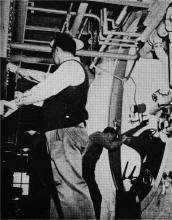 Taming Acetylene. Through a peep-hole
in steel armor, an observer (background) watches a reaction in a new process that
may produce synthetic chemicals for making rubber, textiles, dyes, and medicines.
Its source is acetylene, under high heat and pressure. This is made possible by
new safety techniques, including dilution of the acetylene with inert gas, to reduce
explosion risk. Developed by German physicists, this method is being used for the
first time in the U. S. by the General Aniline & Film Corp. Taming Acetylene. Through a peep-hole
in steel armor, an observer (background) watches a reaction in a new process that
may produce synthetic chemicals for making rubber, textiles, dyes, and medicines.
Its source is acetylene, under high heat and pressure. This is made possible by
new safety techniques, including dilution of the acetylene with inert gas, to reduce
explosion risk. Developed by German physicists, this method is being used for the
first time in the U. S. by the General Aniline & Film Corp.
 Radio Tube Does All Jobs. This new
Sargrove-Tungsgram UA-55™ radio tube (left) can be made to do the job
of any tube in a receiver from RF to audio output. Its split-grid design with a
separate socket contact for each half-grid permits it to be connected in a variety
of ways according to its function. This aids production and servicing of low-cost
radio sets for users in remote areas. The tube's first use was in the mass-produced,
printed-circuit receiver shown at right below (PS, Apr. '48, p. 160). Radio Tube Does All Jobs. This new
Sargrove-Tungsgram UA-55™ radio tube (left) can be made to do the job
of any tube in a receiver from RF to audio output. Its split-grid design with a
separate socket contact for each half-grid permits it to be connected in a variety
of ways according to its function. This aids production and servicing of low-cost
radio sets for users in remote areas. The tube's first use was in the mass-produced,
printed-circuit receiver shown at right below (PS, Apr. '48, p. 160).
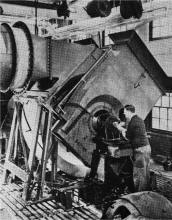 "Tornado" to Cool Pile. Twelve-foot-high
blowers, like the one shown under test in the Westinghouse plant at Boston, will
provide a tornado of air to cool the new atomic pile at Brookhaven National Laboratory,
Upton, N. Y. Each 3 1/2-foot-diameter fan is driven by a 1,500-hp. motor at a 450-m.p.h.
rim speed, yet is said to be unusually quiet. Each one handles 80,000 cubic feet
of heated air a minute. Brookhaven's reactor (PS, Apr. '49, p. 121) is the world's
most powerful air-cooled pile. "Tornado" to Cool Pile. Twelve-foot-high
blowers, like the one shown under test in the Westinghouse plant at Boston, will
provide a tornado of air to cool the new atomic pile at Brookhaven National Laboratory,
Upton, N. Y. Each 3 1/2-foot-diameter fan is driven by a 1,500-hp. motor at a 450-m.p.h.
rim speed, yet is said to be unusually quiet. Each one handles 80,000 cubic feet
of heated air a minute. Brookhaven's reactor (PS, Apr. '49, p. 121) is the world's
most powerful air-cooled pile.
Posted January 2, 2024
|
















